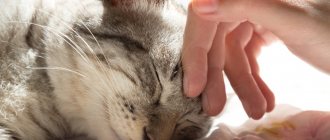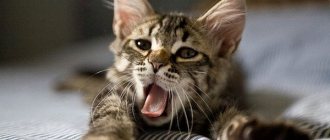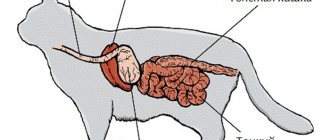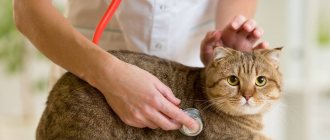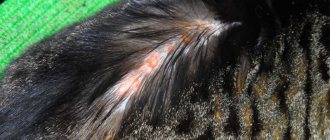Feline hyperesthesia syndrome, which causes discomfort in cats, causes increased skin sensitivity.
Feline hyperesthesia syndrome is also often called twitching skin syndrome, twitching cat syndrome, rolling skin syndrome , atypical neurodermatitis, psychomotor epilepsy and neuritis. No matter what you call it, it's a condition that causes your kitty to experience increased skin sensitivity, so you can imagine how uncomfortable it can be.
Read the information below to learn more about feline hyperesthesia and what you can do if your cat has been diagnosed.
What is panleukopenia?
Before you start fighting a disease, you need to find out what causes it. Feline panleukopenia is an acute infection. It affects the animal's gastrointestinal tract and reduces the content of white blood cells. This is where the disease got its name - panleukopenia. This disease is dangerous not only for felines; even minks or raccoons can catch it. Panleukopenia most often occurs in kittens. A young, still fragile body is most susceptible to this infection. The most dangerous time for your pets is spring and summer. During this period, cats actively breed, and a small, weak fluffy creature infected with this virus can infect its mother. Feline distemper has a high mortality rate, especially among kittens. In recent years, the widespread use of preventive drugs and vaccines has reduced the incidence rate.
Is the disease dangerous for humans and other animals?
Feline distemper is absolutely safe for humans, so a cat can be safely treated without fear of becoming infected. However, the virus is dangerous for other animals. Therefore, in addition to vaccination, it is necessary to disinfect the premises and observe quarantine.
As a disinfectant, you can use regular chlorine bleach in an aqueous solution (ratio 1:32).
In addition, to get rid of the virus, you will have to part with all the things of the sick animal: bedding, toys, drinking and eating utensils, litter trays - and replace them with new ones.
A cat that has recovered from panleukopenia will become immune to the disease, but other pets can still become infected, since it is impossible to get rid of the virus 100%. Therefore, a new pet cannot be acquired earlier than a year later; it must be vaccinated in advance or make sure that it has immunity.
How does a cat become infected with panleukopenia?
Feline panleukopenia is an extremely tenacious infection. In the environment, the virus can survive from several months to a year. This virus is easily transmitted through a person in contact with a sick animal to a healthy cat. In addition, a cat can become infected through a shared bowl or litter tray. The virus is transmitted through fleas, as well as in utero - from an infected animal to its offspring. Feline panleukopenia is transmitted through saliva during mutual licking.
When the virus enters the animal's body, infection of the lymphoid tissue begins. Over the next few days, the pet’s entire body is affected by the panleukopenia virus. The incubation period of infection lasts from 3 days to a week. The virus reduces immunity, affects blood cells, bone marrow and gastrointestinal tract cells. During illness, the animal is very sensitive to other infections.
Types of paralysis in cats
There are several types of paralysis that characterize the degree of the disease. These include symmetrical lesions - paraplegia , in which both lower limbs are involved in the process at once. With hemiplegia , the thoracic and pelvic region is damaged, and paralysis affects the paws on one side of the body.
Tetraplegia is complete paralysis of all four limbs.
In monoplegia , only one limb is affected.
The disease is also divided according to the area affected:
- Facial nerve paralysis.
- Hind limbs.
- Spinal paralysis.
- Laryngeal paralysis.
- Damage to the radial nerve - this disease refers to obstetric injuries that occurred during childbirth.
How does the virus affect an animal?
Distemper is one of the most dangerous diseases for cats. After contracting an infection, there is a strong decrease in leukocytes in the blood. The animal develops heart failure, dehydration, digestive upset, and intoxication of the body. Panleukopenia in kittens is fatal in 90% of cases; among adults this percentage is lower - 40-70%. As described above, distemper in cats weakens the immune system and makes them defenseless against other infections. The death of the animal can occur if it becomes infected with another infection, due to cardiovascular failure or due to dehydration.
How does the treatment work?
It is immediately worth noting that there is no single treatment for the panleukopenia virus for all pets. Each case is individual and must be examined by a veterinarian, the symptoms analyzed and a treatment regimen developed that will be suitable for that particular case, but may not be effective for other pets. Therefore, there is no need to listen to neighbors and relatives who have encountered this problem and know everything about the disease. Only a trip to the veterinarian will speed up the treatment of panleukopenia in cats and contribute to a favorable course of the disease.
The course of treatment can last from one to two weeks, depending on the severity of the disease. But even with visible improvement, you cannot stop the prescribed course in order to avoid possible relapses; this makes panleukopenia dangerous.
These medications are most often prescribed for treatment:
- In case of severe dehydration and intoxication of the cat's body, saline solutions will be prescribed.
- Antiviral drugs.
- If there is a bacterial infection, antibiotics.
- Glucose.
- Vitamins.
Having assessed the animal’s condition, the doctor can additionally prescribe anti-edema, antipyretic, cardiac, painkillers and immunity-boosting medications. During treatment, it will be necessary to show the cat to a specialist several times, this is necessary to adjust the prescribed medications depending on the result of the treatment. Usually the doctor himself explains the schedule of his visit.
How does panleukopenia manifest? Symptoms
If you notice any symptoms in your animal, you should contact your veterinarian, even if it is not panleukopenia. Signs of this disease are accompanied by an increase in temperature to 41°C and even higher. Complete lack of appetite, the animal refuses water and tries to find a dark, secluded place where it will not be disturbed. Usually the cat lies on its stomach with its paws extended or sits with its head bowed low. A sick animal may vomit yellow-green color with mucus and sometimes even blood. The urine becomes light orange in color, diarrhea appears with a strong foul odor, with the presence of blood. The animal is wasting away before our eyes.
In the acute form of the disease, the animal exhibits convulsions. If a veterinarian does not intervene at this stage, the pet will die in 1-2 days. The incubation period of the disease is 10 days, at which time the first symptoms are observed. How they manifest depends on the age of the animal and its immunity. If the pet survives the first 4 days, then the likelihood of its recovery increases significantly. This is especially true for adult cats. The acute form of the disease lasts up to 10 days. During plague, diseases such as conjunctivitis and rhinitis may additionally develop.
Even after the animal begins to recover, do not forget that it is a carrier. The panleukopenia virus is found in cat feces, and complete recovery occurs only after 2 weeks.
Caring for a sick animal
Representatives of the cat family suffering from dangerous diseases, such as distemper or panleukopenia, especially need the care of loving owners.
Provide the cat with a dry and warm place in a regularly ventilated area during treatment. While the room is being ventilated, the cat is usually taken out so that it does not catch an additional cold.
Disinfect the mustachioed patient’s bedding once every 2–3 days. Don't force your pet to eat. At the same time, there must be a bowl of water next to the cat’s bedding.
Each time after an animal defecates, its tray should be washed with bleach and the filler should be changed.
Feeding your cat during and after treatment
With proper treatment of a cat, its appetite begins to return within 2-3 days. The treating veterinarian will always tell a caring owner how to properly feed a sick pet.
The first days of recovery - feed the animal dairy products and meat broth. Later, the food is supplemented with boiled beef and sea fish (previously cleaned of bones).
You can also give boiled eggs. Products should be finely chopped. This diet should be followed for 3-4 weeks.
Forms of the disease
There are three forms of feline distemper: fulminant (superacute), acute and subacute.
The most dangerous lightning form. Most often, it overtakes animals under one year of age and kittens feeding from a cat. If they are only a few weeks old, then when they become infected with panleukopenia, they begin to eat poorly or completely stop drinking milk, lie in one place and do not move, and emit a plaintive squeak. With this course of the disease, babies die after 1-2 days; even timely treatment will not help. There are cases when kittens die for no apparent reason, there are no signs of illness or disease.
In individuals that have reached 3-7 months of age, distemper affects the nervous system. Kittens become timid, hide in dark corners, do not sleep and squeak in fear. The symptoms are the same as in adults. The kittens' fur becomes dull in color and feels dirty and unkempt to the touch. The animal completely refuses food and water and dies within a couple of days without medical intervention.
The acute form of panleukopenia affects adult pets. The first signs of the disease: loss of appetite, the cat is inactive and refuses even rare treats. There is no response to calls, does not respond to his name, does not respond to touch. Heavy breathing is noticeable, sometimes even with wheezing. After 1-2 days, foam appears at the mouth, yellowish-green vomit opens, rarely with blood. Diarrhea appears. The animal's body temperature rises noticeably. After another couple of days, vomiting with mucus appears. The animal completely refuses to drink. At high temperatures, rapid dehydration occurs.
When the virus affects the lungs, the cat tries to cough, while it runs from the nose and eyes. The nose is hot and dry. Such symptoms indicate the possible presence of other infections that act as a catalyst for panleukopenia. Infection with the heart virus causes heart failure and tachycardia.
All these symptoms appear in the first 1-2 days. In the absence of complications and with correctly prescribed treatment, the animal recovers within a week. If nothing is done, the animal will die in 1-2 days. Cats that have overcome this infection continue to carry it for a long time. They shed the virus in their feces and urine. Once recovered, animals receive strong immunity from this disease, almost for life.
Feline panleukopenia, which occurs in a subacute form, has the same symptoms as in the acute form. The only difference is that the symptoms are not so pronounced. This form of the disease is typical for cats with strong immunity, for animals that have been vaccinated against panleukopenia. The disease develops within three weeks. Seeing a veterinarian makes recovery quicker. With this form of the disease, the prognosis for the animal is favorable.
Postpartum paresis
This type must be considered separately. The second name is postpartum hypocalcemia . Occurs during severe “calcium starvation” in females who have just given birth (no later than three to four days after birth). The more kittens in the litter, the higher the risk of complications. For the same reasons, the risk of postpartum paresis is always higher in miniature cats. And for the same reasons, their diet before and during pregnancy should be closely monitored.
Which category of cats is most susceptible to distemper infection?
As mentioned above, among kittens the mortality rate from this disease is more than 90%.
In 3-month-old unvaccinated offspring, the disease can cause serious complications, including death. The incubation period of the virus at this age is 4-5 days, after which the first symptoms described above appear. They appear suddenly, and often pet owners confuse them with poisoning. If nothing is done, the animal may fall into a coma. At this time, cats are not at all protected from other infections. If the animal survives the first four days of the disease, then, as mentioned above, the likelihood of a favorable outcome increases significantly. But there are exceptions, when the animal becomes a little better, and then its condition sharply worsens. In adult vaccinated cats, the disease may be asymptomatic or with mild symptoms.
Pregnant cats may experience miscarriage or stillbirth due to panleukopenia. Sometimes live kittens are born, but with a violation of the coordination apparatus. This is due to the fact that the virus affects the brain, in particular the cerebellum, which is responsible for coordination. Over time, this defect in kittens can be smoothed out, and the babies will be able to live normally. There is also a danger of retinal damage; kittens can become completely or partially blind.
Diagnosis of paralysis in cats
Laboratory diagnostics help identify the cause of the disease.
General blood, urine and biochemistry tests monitor the animal’s condition.
For a detailed check, an MRI of the brain and spine is often required.
If infection is suspected, bacteriological analysis is recommended.
To exclude neoplasms and injuries, ultrasound and radiography are usually used. It is worth conducting Doppler sonography to check the filling of blood vessels and access of blood to the extremities.
The limbs are tested for tendon reflexes, tactile and pain sensitivity. This is done in order to assess the extent of the damage.
Diagnosis of panleukopenia
Feline panleukopenia can only be diagnosed by a veterinarian. A preliminary examination is based on the symptoms described by the owners and the data that the doctor determines independently. The doctor must be informed whether the cat has been vaccinated against this virus, whether it has had contact with other animals in recent days, whether it has had access to the street and other features of the pet’s behavior and well-being in the last 3-4 days. During the examination, the veterinarian will palpate the animal's abdomen (to look for thickened intestines). The abdomen of sick cats is very painful. After a medical examination, the animal is sent to undergo a test for panleukopenia.
Distemper is dangerous because it is very similar to less dangerous cat diseases, and an inexperienced owner may not immediately seek help, which will lead to the death of the animal. However, a veterinarian who is presented with a cat who is vomiting, has diarrhea, has no appetite, and has a high fever will first think of panleukopenia.
Tests showing an increase in white blood cells indicate that the cat is on the road to recovery.
Causes
Feline hyperesthesia syndrome affects the skin as well as the neuromuscular and nervous systems. Unfortunately, experts are not entirely sure what may be causing this rare disease.
Some experts believe there may be a connection between epilepsy and hyperesthesia, or that dry, itchy skin caused by a deficiency of omega-3 fatty acids in the diet may contribute to symptoms. Others suggest that it is a form of obsessive-compulsive disorder or that it may be a result of the cat being stressed.
Treatment of feline distemper
After tests confirm the viral disease panleukopenia, treatment begins immediately.
This disease has high mortality rates; unfortunately, biologists have not yet come up with a single cure. Therefore, treatment consists of maintenance therapy, during which the cat’s body produces the required amount of antibodies. The first antibodies begin to form in the first three days of illness. The animal needs help to fight the symptoms of the disease. Treat dehydration with medications, administer vitamin supplements, provide parenteral nutrition, and control diarrhea and vomiting. In particularly difficult cases, blood transfusions are used. In case of an unfavorable outcome, the death of the animal occurs in the first 4-5 days; if the cat survives this milestone, then, most likely, it will recover. Pets who overcome this disease receive some immunity from this disease in the future.
During rehabilitation therapy, the cat needs the affection and care of the owner. This way she will not lose the will to live and will be able to cope with the virus faster.
IMPORTANT! This virus can exist in the environment for several years, so if the sick cat is not your only pet, be sure to vaccinate the rest.
Treatment of paralysis in cats
Paralysis is a serious symptom and requires immediate medical attention. Therapy will depend on the cause of the disease. It is worth preparing for the fact that the treatment will be lengthy and rarely leads to complete restoration of movements.
It is necessary to take comprehensive measures, which include nutrition, medication and physiotherapy.
In case of paralysis, it is worth giving easily digestible foods, preferably in the form of purees. Nutrition should be complete and include all the necessary vitamins.
For injuries and inflammations, I usually use anti-inflammatory steroids - metipred, preferably administered by drip three times a day.
Injections of B vitamins are used as strengthening therapy; they help speed up the recovery of damaged peripheral nerves.
Pain is relieved with non-steroidal anti-inflammatory drugs -
- Rimadyl,
- carprodil,
- Flexoprofen.
For significant pain, opioid substances are used -
- hydromorphone,
- fentanyl,
- buprenorphine.
If thromboembolism is detected, then anticoagulants are used -
- heparin,
- aspirin,
- clopidogrel.
For injuries and hernias, surgical treatment is recommended. During the operation, bone fragments are compared and the pelvis and spine are restored, and the hernia is truncated.
Tick paralysis has an etiotropic treatment - a special anti-tick serum.
Also, in order to relieve dehydration, dehydration is carried out using droppers with saline solutions.
In cases of respiratory failure, oxygen therapy or mechanical ventilation is performed.
Physiotherapy
Myoelectric stimulation and massages are often used to restore sensitivity. The latter procedure can be carried out at home with prior consultation with a doctor, since in some cases it may be contraindicated.
Perform passive movements with your paws, bending and extending the limb. Stroke and knead them, stimulate walking with the support of the animal, correctly placing the paws when walking.
Vaccinations and other means of preventing feline distemper
The most dangerous disease in cats is panleukopenia.
Its symptoms can easily be confused with signs of another disease or simple poisoning. To avoid having to take your pet to the vet in serious condition, take care of his health in advance. There are certain preventive measures against this dangerous virus. It is known that if a mother cat is immune to this disease, then she provides her offspring with antibodies for the first ten weeks of their life. Then you need to take the babies to the veterinarian and get them vaccinated. Complex vaccines are often used that protect not only against panleukopenia, but also against feline herpes or calcivirus. After the first vaccination, you need to get a second vaccination 28 days later.
Adult cats need to be vaccinated annually.
IMPORTANT! Vaccination can only be given to healthy animals. You cannot vaccinate a pregnant cat, a sick or weakened one, or kittens during teething.
For your pet's well-being, it is necessary to provide it with good nutrition, a clean and warm room, and also remember to regularly visit the veterinarian for preventive procedures.
Prevention of infection
The main measure to prevent infection with the panleukopenia virus is vaccination. Kittens are vaccinated starting at 8 weeks of age. Revaccination is carried out after 2-4 weeks, and then once a year.
Other preventive measures:
- two-week quarantine for newly arrived animals;
- proper nutrition;
- disinfection of premises, bedding, bowls;
- immediate isolation of sick individuals.
A cat that has had panleukopenia should be regularly taken to the veterinarian for a preventive examination.
